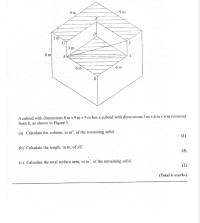You are using an out of date browser. It may not display this or other websites correctly.
You should upgrade or use an alternative browser.
You should upgrade or use an alternative browser.
Cuboid volume: Cuboid 8x9x9 has cuboid 3x6x6 cut out of it.
- Thread starter Laia
- Start date
What is the equation for the volume of a cube of length l, width w & height h ?Hello! Can someone help me on (B) and (C). I can't find any attempts to get the answer. Please help
Can I use the Pythagoras theorem to find the length of AE too?Use Pythagoras's theorem to calculate the length of AC, then calculate the length of AE.
And, how can I find the total surface area of the remaining solid?Use Pythagoras's theorem to calculate the length of AC, then calculate the length of AE.
Yes....Can I use the Pythagoras theorem to find the length of AE too?
I'm sorry but would you mind pointing that out on the picture?
I think that my calculation need some more. I think there is more to to get the total surface area of remaining solids. I add [ 2× (3×9) + 2× ( 3× 8). But I think I need to add more surface but I can't actually generate it
I think that my calculation need some more. I think there is more to to get the total surface area of remaining solids. I add [ 2× (3×9) + 2× ( 3× 8). But I think I need to add more surface but I can't actually generate it
Or is the total surface area of remaining solid = 2× (3×9) + 2 × (3×8) + 2× (6×6) ?I'm sorry but would you mind pointing that out on the picture?
I think that my calculation need some more. I think there is more to to get the total surface area of remaining solids. I add [ 2× (3×9) + 2× ( 3× 8). But I think I need to add more surface but I can't actually generate it
What is the surface area of a rectangle whose length is b and width is w?
Each of he 3 L shaped areas in the figure can be thought of as addition of two rectangles.
lev888
Elite Member
- Joined
- Jan 16, 2018
- Messages
- 2,993
Please do the following:Or is the total surface area of remaining solid = 2× (3×9) + 2 × (3×8) + 2× (6×6) ?
Copy the diagram
Draw additional segments so that all surfaces are divided into rectangles.
For each rectangle write the expression for the area and draw an arrow from the expression to the rectangle
Don't forget the surfaces not visible in the diagram (but they still belong to the shape and need to be taken into account)
Take a photo and post your work.
Do you see that the total surface area (Ao) of the original {prior to cutting the corner cuboid out) right-rectangular cuboid is:
Ao = 2 * (9 * 8 + 9 * 8 + 9 * 9 ) m2

